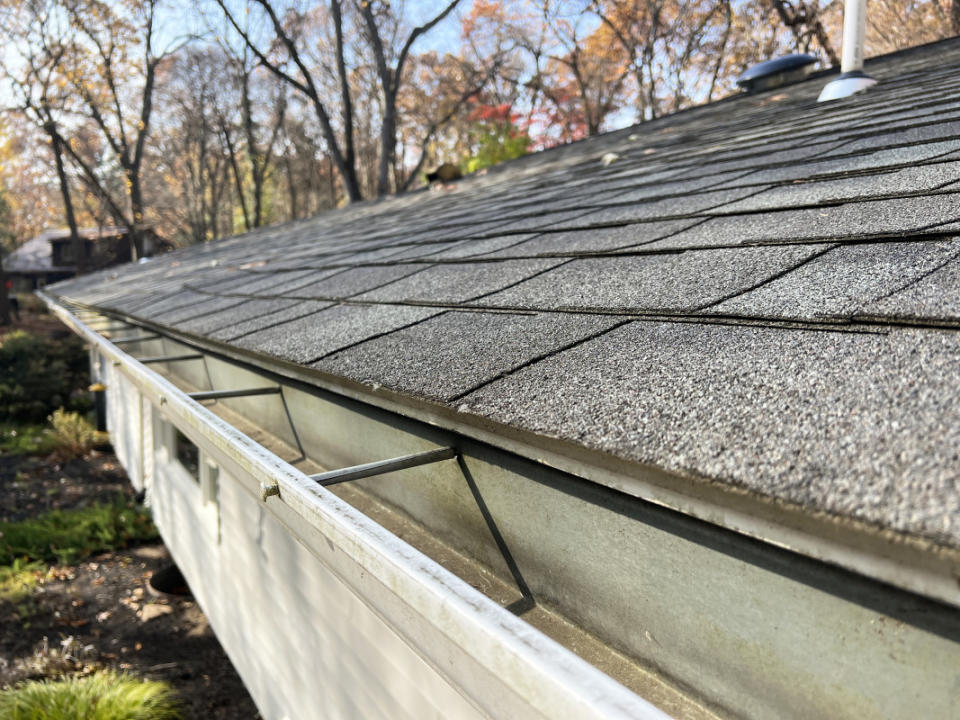How to Check for Gutter Damage After the Winter
As the weather grows warmer and signs of ice and snow pass, it's important to pay attention to any changes that have occurred to the exterior of your home during the winter months. Winter elements play a harsh role in many areas of the country, contributing to extensive damage of gutter systems. Look for obvious signs of damage from ground level, but call in a gutter professional to take a closer look if you have a second or third-floor gutter. Failing to schedule regular gutter inspections and or ignoring visible damage can lead to costly repairs (not to mention, structural issues).
Why is it important to check gutters for damage?
"Gutters are one of the most important long-lasting solutions against structural home damage caused by water," shares Chris Counahan, President at Leaf Filter. "With the typical life expectancy of gutters being around 20 years, neglecting gutter maintenance can impact every aspect of your home, such as water damage to the roof, foundation, and walls, as well as the potential for mold growth."
He adds, "If gutters are not cleaned regularly and water overflows from the gutters, water can fall along the foundation of your home, freeze, and result in cracks. Gutters should be checked and cleaned twice a year to prevent damage to your roof and foundation. Spring is a good time to tackle this project to give your gutters a fresh start after the snow has melted, especially since it’s common for underlying problems to rear during the winter."
1. Gather Tools and Materials
To inspect and clean your rain gutters, pull together a tool bag with:
work gloves
hammer
gutter hangers – just in case you need to do some rain gutter repair
extension ladder
bucket for debris
If you can't confidently and safely check your clogged rain gutters, don't hesitate to call a roofing expert so they can help provide maintenance. A DIY gutter inspection isn't for every household.
2. Do a Visual Inspection—Inside and Out
Perform a visual inspection around your home to look for gutter issues that are out of the ordinary. "Ice dams can create leaks that you don't even notice until the snow melts," notes Counahan. "Ice dams are a buildup of ice in your gutters that stops water from flowing, causing water to pool and freeze. Frozen gutters trap snow and ice on the surface of your roof, which can damage or loosen your shingles, weaken your roof, and cause potential water damage inside your home."
If you had an ice dam, you might see:
Water stains on ceilings and walls
Water leaks in the attic (or damaged insulation)
Damaged, dislodged, or cracked shingles
Clogged gutters that are unable to accommodate heavy rain can cause damage not only to the roof and shingles but also to the foundation of your home. A waterfall from a gutter that pummels the ground next to a home's foundation can erode and oversaturate the soil, causing excess moisture to gather around the home's foundation. Not only could this result in basement flooding, but due to a reoccurring freeze-thaw cycle, it could actually cause foundation cracks and lead to other foundation issues. As you inspect outside the home, you might notice if rainwater has been pooling near your foundation. For example, if you have mulched garden beds, the mulch may have washed away from areas beneath your gutters. Regular cleaning can help mitigate debris accumulation and spare you expensive gutter and roof repairs over time.

Emily Fazio
3. Remove Dry Leaves and Branches
Up on the ladder, reach into the gutters around your home and extract any branches and leaves that have built up. Put that debris in the bucket to simplify cleanup.
While you're inspecting up close, check for gaps between the gutters and the fascia boards. Gaps in the gutter apron can occur when the hangers or spikes that hold the gutter loosen over time. If you see gaps, you might be able to fix them by tapping the spikes back in. If they won't hold, use an additional hanger to re-secure the gutter to the roofline.
Don't Forget to Check the Downspouts
Just like your clogged gutters, a home's downspouts can fill with ice during the winter, causing further problems in the spring as seasons change. "By keeping them clear, you are keeping them from cracking or sagging under the ice pressure."
4. Use a Hose to Flush Debris
A garden hose simulates heavy rainfall and helps rinse out any remaining debris, like pine needles, from the gutters. Monitor the flow of water during this DIY gutter cleaning. This is also a great time to check for water leakage between gutter sections.
5. Check the Gutter Slope
"The added weight of winter snow on your gutters can cause them to break away from your roof, which can damage or loosen your shingles, weaken your roof, and cause leaks inside your home," shares Counahan. "When spring comes around, signs to look for that your gutters need replacing include if they’re warped or pulling away from the home, aren’t draining properly, or debris is getting stuck in them."
If you can see inside your gutters, one sign of a broken gutter can be stagnant water. If the rainwater (or your hose water) no longer demonstrates proper water drainage to the downspout, the pitch of the gutter may have shifted due to the weight of snow and ice.

